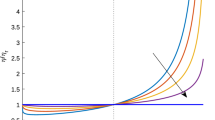Abstract
Survival analyses of populations are developed in dicrete growth processes. Persistence and extinction attributes of age-structured discrete population models are explored on both a finite and infinite time horizon. Conditions for persistence and extinction are found. Decompositions of the initial population size axes into intervals where populations are persistent at timeN and intervals leading to extinction at timen, wheren≤N, are given for two age class discrete population models.
Similar content being viewed by others
Literature
Capildeo, R. and J. B. S. Haldane. 1954. “The Mathematics of Bird Population Growth and Decline.”J. Anim. Ecol. 23, 215–223.
Cull, P. and A. Vogt. 1973. “Mathematical Analysis of the Asymptotic Behavior of the Leslie Population Matrix Model.”Bull. math. Biol. 35, 545–661.
Geramita, J. M. and N. J. Pullman. 1984. “Classifying the Asymptotic Behavior of Some Linear Models.”Math. Biosci. 69, 189–198.
Green, R. H. 1979. “Matrix Population Models Applied to Living Populations and Death Assemblages.”Amer. J. Sci. 279, 481–487.
Hallam, T. G. 1986. “Population Dynamics in a Homogeneous Environment.” InMathematical Ecology: An Introduction (T. G. Hallam and S. A. Levin, Eds),Biomathematics, Vol. 17, pp. 61–94. Berlin: Springer-Verlag.
— and S. A. Levin (Eds). 1986.Mathematical Ecology: An Introduction, Biomathematics, Vol. 17. Berlin: Springer-Verlag.
Hutson, V. and W. Moran. 1982. “Persistence of Species Obeying Difference Equations.”J. math. Biol. 15, 203–213.
Kot, M. and W. M. Schaffer. 1984. “The Effects of Seasonality on Discrete Models of Population Growth.”Theor. popul. Biol. 26, 340–360.
Levins, R. 1970. “Extinction.” InSome Mathematical Questions in Biology, Vol. 2, pp. 75–107. Providence, R.I.: American Mathematical Society.
Li J., T. G. Hallam and Z. Ma. 1987. “Demographic Variation and Survival in Discrete Population Models.”IMA J. Math. app. Med. and Biol. 4, 237–246.
May, R. M., (Ed.), 1976.Theoretical Ecology: Principles and Applications. Philadelphia: Saunders.
Maynard Smith, J. 1968.Mathematical Ideas in Biology. Cambridge: Cambridge University Press.
Nicholson, A. J. and V. A. Bailey. 1935. “The Balance of Animal Populations, Part I.”Proc. Zool. Soc. London 3, 551–598.
Pielou, E. C. 1977.Mathematical Ecology. New York: Wiley-Interscience.
Sykes Z. M. 1969. “On Discrete Stable Population Theory.”Biometrics 25, 285–293.
Tschumy, W. O. 1982. “Competition between Juveniles and Adults in Age-structured Populations.”Theor. Pop. Biol. 21, 255–268.
Wolda, H. 1970. “Variation in Growth Rate in the Landsnail Cepaea Nemoralis.”Res. Pop. Ecol. 12, 185–204.
Author information
Authors and Affiliations
Rights and permissions
About this article
Cite this article
Li, J. Persistence in discrete age-structured population models. Bltn Mathcal Biology 50, 351–366 (1988). https://doi.org/10.1007/BF02459705
Received:
Revised:
Issue Date:
DOI: https://doi.org/10.1007/BF02459705




